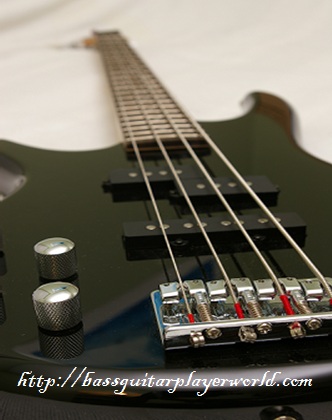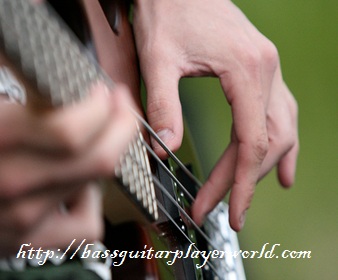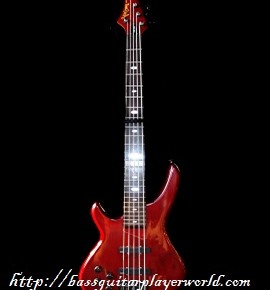Bass Guitar Scales Lessons

Scroll down to see list of lessons…
The foundation of music, believe it or not, isn’t actually riffs and solos. It is scales. Every single riff or solo or rhythm you have ever heard follows a scale.
Even Billy Sheehan follows scales when he is shredding. In fact, that is why he is able to shred so efficiently; he knows his scales and has come to master them through hard work and dedication.
So how can you learn your bass guitar scales?
A good knowledge of bass guitar scales and music theory will improve your playing tremendously. To cite a few examples, learning bass scales will allow you to write your own songs, play in different styles of music, jam along to other musicians and fast progressions in your musicianship.
Why so? If you have basic knowledge of music theory and scales, you can easily jam along with a live band simply by knowing the key that the song is in. You will know what the notes that are appropriate to be played when you are improvising on the bass.
Also, different kinds of scales (e.g. major and minor scales) sound differently. This is also reflected in the mood of the song created in major (happy) or minor (sad) keys. Having the knowledge of scales will also help your creative juice flowing and allows you to apply your theory knowledge into practical playing. In short, you do not have to play around with notes blindly just to know which ones will get you the ideal effects.
Why Go Through a Process of Learning Theory?
 By utilizing these fundamental music theories, you’ll be able to express feelings in your music and vice versa, you will also be able to home in on different styles of music. Say for example, you want to play country music. The cool thing to know is that different scales bring along different flavours to them.
By utilizing these fundamental music theories, you’ll be able to express feelings in your music and vice versa, you will also be able to home in on different styles of music. Say for example, you want to play country music. The cool thing to know is that different scales bring along different flavours to them.
In flamenco music, the use of Phrygian guitar modes is used to add a distinct Spanish taste to the sound. On the other hand, the use of major pentatonic scales is the cornerstone for country music.
This scale gives country it’s distinct upbeat and happy sounding music. The idea here is that certain styles of music makes use of certain scales. You can add a huge repertoire of sound diversity by mastering bass scales.
The important question now is; “Great! How can I learn to play scales?”. This section of lessons was specially created for you to learn some of the most commonly used scales in music. By learning them, you will find that this knowledge will uncover previously undiscovered avenues in your playing.
Lesson Listing – Scales on Bass Guitar:
#1 – Getting Started With the Major Scales
This is the most fundamental scale in music. Essentially, all other kinds of guitar scales or chords can be derived or retraced backwards to the major scale. Not surprisingly, this is the easiest scale to pick up and is a must-know.
#2 – What You Need to Know About the Minor Scales
Along with the major scale, the natural minor scale is an essential that all bassists need to learn and master under their belts. In this article, we will reveal several concepts behind them and how to correctly utilize them in your music.
#3 – Minor Pentatonic Scales for Rock And Heavy Styled Music
The minor pentatonic scale is a 5 note sequence that is simple to learn and easy to apply in your everyday playing. It’s very popular in rock or hard rock genres of music.
#4 – Pentatonic Scales And How to Play Them Effectively
Learn the theory behind the pentatonic scales on the bass guitar with a video tutorial. Besides the basic fundamentals, we are also going to look at practical applications and when you can showcase them.
#5 – How to Practice Bass Guitar Scales Effectively
I know it is a chore to practice scales. Most bassists and guitarists dread it. But, if you want to improve your overall musicianship, this is what you need to do to help train your ears, fingers and overall understanding of music.
#6 – Chromatic Scales For Improvising And More
If there’s one scale that most people don’t need to memorize, its the chromatic scale. With half steps between each interval, it is easy to learn the theory behind it but not that straightforward in practical usage. This scale is usually used for improvisation or ab-lib purposes.
#7 – Melodic Minor Scale to Create Distinct Sounding Tones in Music
The melodic minor is a variation of the bass natural minor scale. With raised notes during accession, it creates a very unique flavor to your music playing.
#8 – Learn the Practical Usages of the Ionian Modes
Though the C ionian mode is essentially contains the same notes as a C major scale, the context in which it is applied to is usually different. Find out more as we explain with examples and indepth videos.
#9 – Master the Dorian Modes And Correctly Apply Them in Your Music
The dorian mode is a variation of the natural minor except that it has a raised 6th. While most people are familiar with the fact that D dorian consists of the same notes as the C major scale, not many people can appreciate the full flavor of the mode which is only brought out over certain chords (e.g. D dorian over D minor chords) it is played with.
#10 – Create Spanish Sounding Licks With the Phrygian Mode
The phrygian mode creates a spanish/flamenco feel. While there are lots of practical uses for this mode, one of the best ways to explore your creativity and learn more about them is through practice.
#11 – Lydian Modes to Help Improvising Bassists Create Happy And Upbeat Tones
The lydian mode is a close cousin of the Ionian mode and creates a happy feel to it. However, what is potentially useful to the improvising musician is that it can help create unusual flavors and musical tension when used right.
#12 – Jazz Style Musician’s Guide to the Mixolydian Modes
Like the Lydian mode, the Mixolydian mode is one of the more interesting scales for the bass guitar. Generally speaking, this mode has found its way as a staple tone for jazz music. However, its uses has also extended into achieving cool blues and country sounds.
#13 – Aeolian Scales And Modes That Are Commonly Found in Popular Music
The Aeolian mode is the diatonic scale of the natural minor. This is a mode in which many of us are familiar with due to its common usage in western and rock music. If you are interested in such genres, this is a lesson you don’t want to miss.
#14 – Locrian Modes And Its Usage in Death/Heavy Metal Genres
The locrian mode stands out from its other counterparts due to the tensive and dissonance feel it creates. Most musicians find the unresolved dissonance unpleasing and hence, it hasn’t found much usage. However, they are frequently used in heavy metal or death metal music.
#15 – Melodic Minor Modes – How to Utilize the Them In Your Playing
This is a lesson that stems from the earlier article on melodic minor scale. Find out more about how to apply the modes to your playing and what they can do for you to achieve a particular sound or feel.
Bass Scales For Beginners – A Detailed Look at Specific Topics
Related Articles
Comments are closed.





